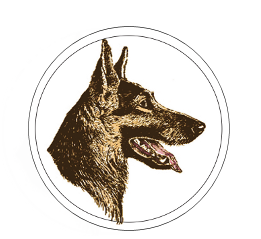DOG DISPLAYS
John Cox
Most Clubs are involved, at some time or another in dog displays, either on an In-House basis, for members, or for outside organisations. A dog display is an ideal practical way to advertise a club’s existence and activities, but we must not forget, that there is such a thing as a ‘bad’ display and if we are not careful, we can do more harm than good. It is important when undertaking a display, that we remember the prime purpose is usually to ‘entertain’. Certainly, some specialist displays are designed to provoke thought amongst other trainers, handlers or professional bodies, with an interest in a specific training discipline. However, generally speaking, we put on dog displays to entertain the crowd. The main point which I am trying to make, is that there is a tendency to design a display that pleases the handlers, and one often loses sight of the relatively limited canine experience of the audience. What seems impressive to us, often becomes quite boring for the spectators. Other than Clubs members, few people fully appreciate an extended advanced Heel course with its routine Sits, Down and Stands on the move. Sure, this sort of thing has its place in a display, even if it is only as an introductory filler for the commentator, but keep it short, sharp and to the point.
Dog display spectators are in the main, more ignorant and indeed more forgiving, than the competition judge. For this reason, we should try to be as imaginative and practical as possible with our display word. The average crowd likes action. We must give them little chance to engage in idle conversation. In fact, we must keep their attention. Obviously, a good commentary can enhance an otherwise weak display programme and one should never underestimate the value of a ‘switched on’ commentator. He or she can cover up a multitude of sins and in an instant turn a mistake to your advantage. There is one characteristic for a dog display spectator however that is not so forgiving. Never jerk your dog around on the lead or in any other way chastise the animal in view of crowd. You can encourage your dog as much as possible and even your animal, but never give the impression that you are angry with it, or you will lose the sympathy of those who are watching. Often, a good way to ‘test’ your display programme, is to invite a sample audience of one or two people to watch a rehearsal. Upon completion of the practice, quiz the observers on what they found most enjoyable. You may be surprised.
An essential part of a good display is timing. One activity is immediately followed by another, no gaps or pauses. The impact will quickly be lost if the crowd have to wait whilst equipment or jumps are moved into place. Continuity is vital. The basic content of any display will, to a great extent, be dictated by the make-up of the audience. I have always found that children are easiest to cater for, in that they are easily impressed. One must be careful not to get too technical by including some of the standard scent exercises. Try a little imagination when using the scenting capabilities of the dog. Be more practical and exciting. A handler’s purse is stolen and the dog must locate the thief amongst a line of suspects, or you lose your 10c parking meter money whilst walking across the arena. Fire, attacks, gunshot, variations on agility equipment are all crowd pleasers and one can seldom do too much of this sort of thing in your programme.
Comedy is another useful ingredient and where possible this should be included. Often, we get a laugh unintentionally when, for example, a dog misses out a jump or goes under one instead of over. Involving oneself in dog displays is good for your dog. It certainly adds a new and more interesting practical dimension to our training schedule. It gives us the chance to experiment. The dogs themselves seem to enjoy display work and this is probably due to the lack of competition nerves on the part of the handlers. One should be careful however, as it is possible that too much repetition of certain display routines can adversely affect competition test. I found for example, that on hearing gunshot, my dog anticipated an attack, and this started to result in what could be interpreted as unsteadiness. Club members who do not normally show an interest in competing can often be encouraged to join your display team, and this sometimes provides the catalyst that generates greater motivation. I feel that every club should have a display team, and membership to this group should be just as highly prized as promotion to be the ‘senior’ class. Often, we find ourselves being pressed into putting on a display at relatively short notice, so we should really be constantly thinking about and working on new display ideas. Good luck with your display and remember the secrets are slickness, professional commentary, lots of interesting action, an efficient well briefed and practiced arena party and good continuity
